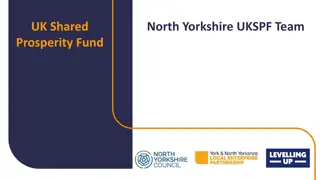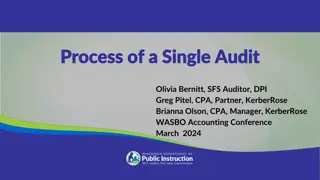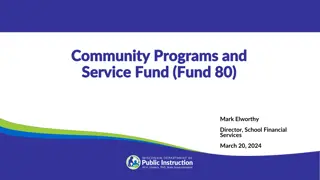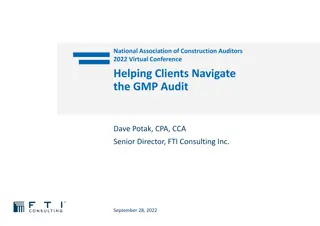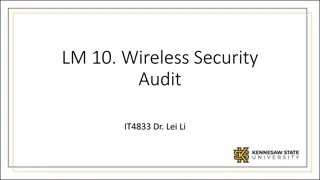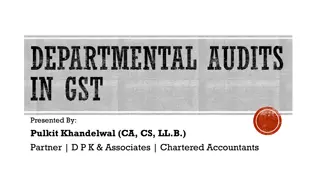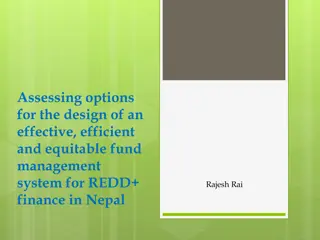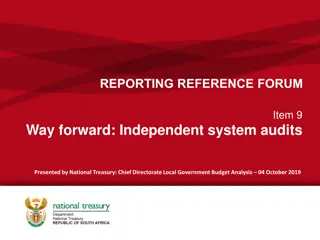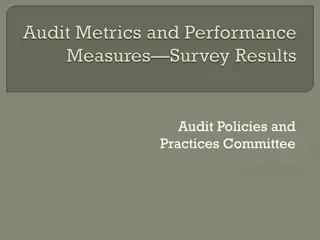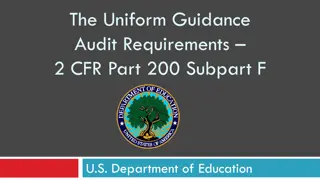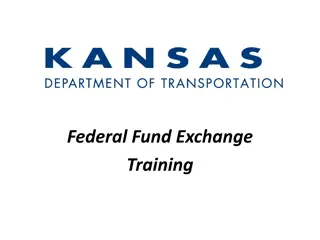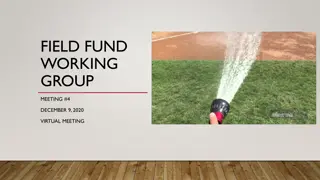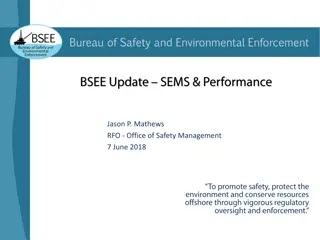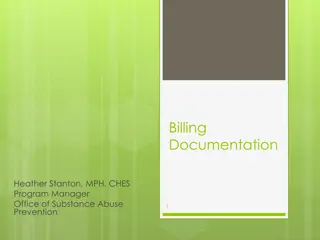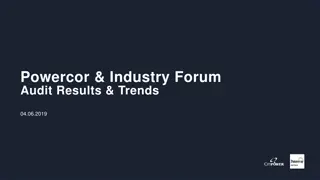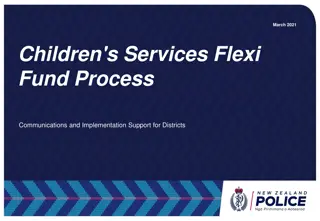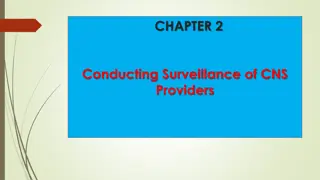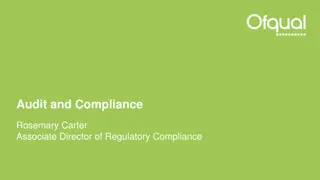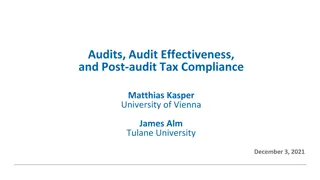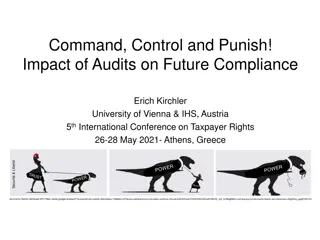Understanding Single Audits for Federal Fund Compliance
Explore the process and requirements of single audits for federal fund compliance, including when they are required, the responsibilities involved, and the importance of OMB Compliance Supplement. Learn how single audits provide assurance to federal agencies about fund usage compliance and the standards to be followed. Prepare effectively for a single audit and understand what to expect during and after the audit.
Download Presentation

Please find below an Image/Link to download the presentation.
The content on the website is provided AS IS for your information and personal use only. It may not be sold, licensed, or shared on other websites without obtaining consent from the author. Download presentation by click this link. If you encounter any issues during the download, it is possible that the publisher has removed the file from their server.
E N D
Presentation Transcript
Process of a Single Audit Tim Coulthart, Assistant Director Olivia Bernitt, Auditor WASBO Accounting Conference March 17, 2021
Process of a Single Audit Agenda What is a Single Audit? When is a Single Audit Required? OMB Compliance Supplement Written Procedures How to Prepare for a Single Audit What to Expect During the Single Audit What to Expect After the Single Audit 2
What is a Single Audit? An audit of federal funds as required by 2 CFR part 200, subpart F of Uniform Guidance to determine that the receiving entity was in compliance with the direct and material compliance requirements of the program per the OMB Compliance Supplement. Specific Auditee responsibilities are Sections 200.508-512 Authority of the Single Audit comes the Single Audit Act of 1984, then updated in the Single Audit Act Amendments of 1996 3
What is a Single Audit? Specific Auditee responsibilities are Sections 200.508-512: 200.508 Audit responsibilities 200.509 Auditor selection 200.510 Financial statements 200.511 Audit findings follow-up 200.512 Report submission 4
What is a Single Audit? Single audits are used to provided assurance to the federal agencies granting the funds that the use of the funds is in compliance with the program s requirements and Uniform Guidance. The single audit for Districts includes: - the financial statement audit in accordance with AICPA standards (GAAS) and Government Auditing Standards (Yellowbook or GAGAS) AND a - compliance audit in accordance with GAAS and Uniform Grant Guidance 5
When is a Single Audit Required? Non-Federal entities that expend $750,000 or more in a fiscal year in Federal awards shall have a single or program-specific audit conducted in accordance with the provisions of the Uniform Grant Guidance. A single audit is required annually for districts that expend $750,000 or more in a fiscal year in Federal awards. 6
OMB Compliance Supplement The OMB Compliance Supplement details the compliance requirements that the awarding agency expects the auditor to test and suggests audit procedures. The compliance supplement for 2020 was issued August 14, 2020 with an addendum issued December 22, 2020 Link to the compliance supplement and the addendum: https://www.whitehouse.gov/omb/management/office-federal-financial- management/ 7
OMB Compliance Supplement The compliance supplement is made up for 8 parts: - Part 1 Background, Purpose, and Applicability - Part 2 Matrix of Compliance Requirements - Part 3 Compliance Requirements - Part 4 Agency Program Requirements - Part 5 Cluster of Programs - Part 6 Internal Controls - Part 7 Guidance for Auditing Programs Not Included in this Compliance Supplement - Part 8 - Appendices 8
OMB Compliance Supplement Department of Education 84.010 Title I Grants to Local Educational Agencies (Title I, Part A Of The ESEA) 84.011 Migrant Education-State Grant Program (Title I, Part C Of ESEA) 84.027 Special Education Grants to States (Idea, Part B) 84.041 Impact Aid (Title VII of ESEA) 84.048 Career and Technical Education Basic Grants to States (Perkins V) 84.173 Special Education Preschool Grants (Idea Preschool) 84.282 Charter Schools 84.287 Twenty-First Century Community Learning Centers 84.365 English Language Acquisition State Grants 84.367 Supporting Effective Instruction State Grants 84.425D Education Stabilization Fund Under the Coronavirus Aid, Relief, and Economic Security Act 9
OMB Compliance Supplement Department of Agriculture 10.553 School Breakfast Program (SBP) 10.555 National School Lunch Program (NSLP) 10.556 Special Milk Program For Children (SMP) 10.559 Summer Food Service Program For Children (SFSP) 10.558 Child and Adult Care Food Program (CACFP) 10.582 Fresh Fruit and Vegetable Program Department of Health and Human Services 93.778 Medical Assistance Program 10
OMB Compliance Supplement Part 2 Matrix of Compliance Requirements - There are 12 compliance requirements that could be applicable to be tested for each federal program. - The Matrix indicates what compliance requirement is subject to audit for each Federal program listed. 11
OMB Compliance Supplement Part 3 Compliance Requirements (applies to all grants) Each of the 12 compliance requirements have suggested audit procedures that Districts should familiarize themselves with The 12 compliance requirements are: - Activities Allowed or Unallowed - Cash Management - Equipment Real Property Management - Matching, Level of Effort, Earmarking - Period of Performance - Program Income - Subrecipient Monitoring - Allowable Costs/Cost Principles - Eligibility - Procurement, Suspension & Debarment - Reporting - Special Tests and Provisions 12
OMB Compliance Supplement From Part 4 the 12 compliance requirements from the Compliance Supplement for Title I are: 13
Written Procedures Auditors will ask to review written procedures; For single audits, if there are no written procedures there will be a finding; and A finding will lead to terms and conditions being added to the subrecipient s grants through DPI s annual risk assessment. DPI does not provide sample written procedures. Part 6 of the compliance supplement 14
Written Procedures Written procedures are not policies. A policy may state, Only allowable costs will be charged to the XXX grant. The procedures are the district s internal steps for ensuring that only allowable costs will be charged to the grant. Required to have written procedures for allowable costs, cash management, purchasing and conflict of interest. Uniform Grant Guidance Written Procedures: https://dpi.wi.gov/wisegrants/uniform-grant-guidance/writtenprocedures 15
Written Procedures Allowability of Costs: - Required written procedures must address how the subrecipient is ensuring that costs on the federal grant, and ultimately claimed, are allowed under the individual Federal program and in accordance with the cost principles established in the Uniform Grant Guidance. 200.302(b)(7) - For payroll, this includes documentation of time and effort. Charges to federal awards must be based on records that accurately reflect the work performed. 16
Written Procedures Cash Management: - Required written procedures must address both advance payments and cost reimbursement. The written procedures should include steps involved in obligating, liquidating, and claiming of federal funds, 200.302(b)(6) and 200.305 - Cost reimbursement is requesting federal funds for expenditures after they have been liquidated. - Advance payment is requesting federal funds for expenditures not yet incurred. 17
Written Procedures Procurement: - The district must use its own documented procurement procedures which reflect applicable State and local regulations, provided that the procurements conform to applicable Federal laws and the UGG, 200.319(d) - The district must have written procedures regarding solicitations to ensure that all procurement transactions are conducted in a manner providing full and open competition. - Maintain written standards for Conflict of Interest 200.318(c)(2) 18
Written Procedures Procurement: - The district must maintain records sufficient to detail the history of procurement. Records must include, but not limited to: 200.318(i) Rationale for the method of procurement Selection of contract type Contractor selection or rejection The basis for contract price 19
Written Procedures 5 Methods of Procurement 200.320 1) Micro-purchase 2) Small Purchase 3) Sealed Bids 4) Competitive Proposals 5) Noncompetitive Proposals 20
Written Procedures Micro-purchases: - The non-federal entity is responsible for determining an appropriate micro-purchase threshold based on internal controls, an evaluation of risk and its documented procurement procedures. - Aggregate dollar up to $10,000 but under certain conditions may be increased to $50,000 - When practical, distribute equitable among qualified suppliers - No competitive quotes required if management determines price is reasonable. 21
Written Procedures Small purchases: - Purchases up to the Simplified Acquisition threshold - Informal procedures acceptable - Price or rate quotes must be obtained from an adequate number of sources 22
Written Procedures Sealed Bids: - Purchases over the Simplified Acquisition Threshold - Formal Solicitation required - Fixed Price awarded to a responsible bidder who conformed with all material terms and is the lowest in price. - Most common for construction contracts 23
Written Procedures Competitive Proposals: - Purchases over the Simplified Acquisition Threshold - Formal Solicitation required - Fixed Price or cost-reimbursement contracts - Used when sealed bids not appropriate - Awarded to responsible firm whose proposal is most advantageous to the program, with price being one of the considered factors. 24
Written Procedures Noncompetitive Proposal: - May be used only when one or more of the following apply: The item is available from a single source The public exigency or emergency for the requirement will not permit a delay resulting from competitive solicitation The federal awarding agency (or pass-through entity-DPI) express authorizes this method in response to a written request from the non-federal entity After solicitation of a number of sources, competition is determined inadequate 25
How to Prepare for a Single Audit The auditee prepares the Schedule of Expenditures of Federal Awards (SEFA) for the year ended. Review the compliance supplement to know what the auditors will be reviewing. Assess the district s control environment and determine that the district has the proper controls in place to ensure they are in compliance with their grant requirements. Ensure they have written procedures as previously discussed. 26
How to Prepare for a Single Audit Districts should have documentation readily accessible for auditors to review for each of their grants. Additional cost Let auditors know that you believe you may need a single audit early so that they can plan accordingly. If you believe you will be close to the threshold or are unsure, contact auditors to have them help you determine if a single audit is needed 27
What to Expect During the Single Audit Risk Assessment and Major Program Determination: - Major programs are the programs that the auditor will test during the Single Audit. - Auditors complete a risk assessment on the programs and the district. - The district can either be high risk or low risk. The risk level determines the total dollar amount to test to meet coverage. 28
What to Expect During the Single Audit Additional time needed during fieldwork Walk through with grant administrator on controls and compliance relating to the grant. Go through the written procedures. May be more than one program being tested depending on the auditor's risk assessment. 29
What to Expect During the Single Audit Have supporting documentation readily available. Auditors will be reviewing supporting documentation for the major program/programs they are testing. There will likely be samples to test each of the different compliance requirements noted earlier that are direct and material to the program. Testing will be done both for internal controls over compliance and compliance requirements. 30
What to Expect After the Single Audit Data Collection Form Communication of Findings If there were findings, providing a corrective action plan If any noncompliance is identified, Districts should be prompt when completing any required follow up action 31
QUESTIONS? 32
THANK YOU! Tim Coulthart, Assistant Director 608-264-9331 Timothy.Coulthart@dpi.wi.gov Olivia Bernitt, Auditor 608-261-2137 Olivia.Bernitt@dpi.wi.gov Visit our website: http://dpi.wi.gov/sfs 33



